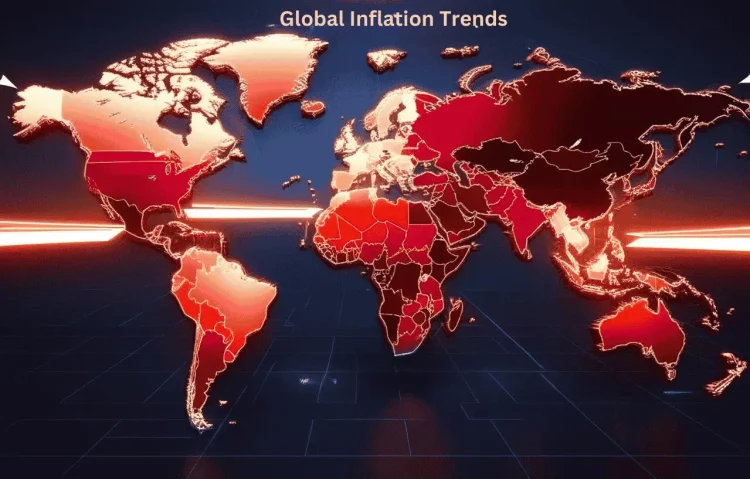Introduction
Inflation has become a central issue in global economies, especially after the unprecedented disruptions caused by the COVID-19 pandemic, supply chain bottlenecks, and geopolitical instability. As inflationary pressures continue to rise across the world, central banks are forced to take a closer look at their monetary policies to stabilize prices and maintain economic growth. While many central banks are using similar tools to curb inflation, such as interest rate hikes and tightening the money supply, their approaches differ significantly based on regional economic conditions and local inflation drivers. In this article, we will analyze how major central banks are addressing inflation, the varying factors driving inflation in different regions, and the potential long-term impacts of these policies on global markets.
Central Banks’ Strategies to Combat Inflation
1. The U.S. Federal Reserve (Fed)
The U.S. Federal Reserve, led by Chairman Jerome Powell, has adopted a more aggressive stance in combating inflation compared to many other central banks. Having kept interest rates at near-zero levels for years to support the economy through the pandemic, the Fed started raising interest rates in 2022 in response to soaring inflation, which hit a 40-year high in 2022. By increasing rates, the Fed aims to reduce consumer and business spending, which should, in theory, help curb inflation.
The Federal Reserve’s actions are focused on tightening the money supply and making borrowing more expensive. In addition to interest rate hikes, the Fed has also implemented quantitative tightening (QT), meaning it is gradually reducing the amount of bonds and other assets on its balance sheet. The goal is to rein in liquidity in the financial system, which has ballooned during the pandemic.
Economic Impact of the Fed’s Strategy
The Fed’s interest rate hikes and quantitative tightening are expected to cool down the overheated U.S. economy. However, these measures come with risks, such as the potential for a slowdown in economic growth, higher unemployment, and even the risk of a recession. While the Fed is trying to strike a delicate balance between controlling inflation and fostering growth, its actions are likely to have significant impacts on U.S. financial markets, especially in sectors sensitive to interest rates like housing and consumer credit.
2. European Central Bank (ECB)
The European Central Bank (ECB) has faced a different set of challenges compared to the Fed. Although inflation in the Eurozone has reached levels not seen in decades, its causes are somewhat different. The Eurozone economy has been grappling with sluggish growth and high unemployment even before the pandemic. Moreover, inflationary pressures have been exacerbated by the energy crisis due to Russia’s invasion of Ukraine, which has led to skyrocketing energy prices across Europe.
Unlike the Fed, which started raising rates earlier, the ECB has been more cautious in its approach. For much of 2022, the ECB resisted raising interest rates, fearing that doing so could stifle an already weak recovery. However, as inflation surged, the ECB had to recalibrate its policy, announcing its first interest rate hike in over a decade in July 2022. ECB President Christine Lagarde has indicated that further tightening could follow, but the pace may be slower compared to other major central banks, as Europe grapples with the fallout of the energy crisis.
Economic Impact of the ECB’s Strategy
The ECB’s more cautious approach to rate hikes aims to avoid overburdening already struggling economies in the Eurozone. However, the ECB is in a difficult position as it must balance inflation control with economic recovery. With high energy costs and an ongoing war in Ukraine impacting supply chains, Europe’s economic recovery could be at risk if inflationary measures are too aggressive. Moreover, the ECB faces challenges in harmonizing policies across the diverse economies of the Eurozone, which have varying inflationary and growth conditions.

3. Bank of England (BoE)
The Bank of England (BoE) has faced a unique set of inflationary pressures, including rising energy prices, the ongoing impacts of Brexit, and labor market shortages. As inflation reached over 10% in 2022, the BoE began raising interest rates to address the situation. The BoE, led by Governor Andrew Bailey, has indicated that it is prepared to take further actions to address inflation but also faces concerns about the economic slowdown.
The BoE’s policy decisions have been more reactive compared to the Fed, as the central bank has had to deal with inflationary pressures alongside the challenges posed by Brexit and the slow recovery in the labor market. Additionally, the BoE’s ability to raise interest rates is constrained by the need to ensure that consumer confidence remains intact and that businesses are not negatively impacted by overly aggressive tightening.
Economic Impact of the BoE’s Strategy
The BoE’s interest rate hikes are expected to curb inflation over time but also risk slowing down an already fragile post-Brexit economy. There is a concern that aggressive rate hikes could lead to a reduction in consumer spending, higher borrowing costs for businesses, and slower growth. With the BoE needing to manage the potential for a cost-of-living crisis, it has to be cautious in its approach to tightening.
4. Bank of Japan (BoJ)
The Bank of Japan has taken a markedly different approach to inflation control compared to other central banks. For decades, Japan has struggled with deflationary pressures, and its central bank has relied heavily on aggressive monetary policy, including ultra-low interest rates and quantitative easing, to stimulate economic activity. Even as inflation began to rise globally, Japan remained relatively immune to the surging prices, until recent months.
In response to rising inflation, the BoJ has continued to maintain its ultra-low interest rate policy, emphasizing that it will do everything in its power to stimulate domestic demand and support economic growth. However, with global inflation rising, Japan’s inflation rate has started to approach levels not seen in years. Despite the global trend of tightening, the BoJ remains committed to its accommodative monetary policy stance.
Economic Impact of the BoJ’s Strategy
The BoJ’s policies aim to support Japan’s export-driven economy by keeping the yen relatively weak and encouraging investment. However, the BoJ’s ultra-low interest rates have also raised concerns about financial stability and the potential for asset bubbles in the country’s property and stock markets. Furthermore, as Japan is a major importer of energy, rising global prices could increase inflationary pressures and impact Japan’s trade balance.
5. People’s Bank of China (PBoC)
China’s approach to inflation has been focused on balancing its rapid economic recovery post-pandemic with inflationary pressures. The People’s Bank of China (PBoC) has generally taken a more cautious approach to tightening monetary policy compared to other central banks. In 2022, China faced relatively low inflation compared to other major economies, but the government has been concerned about rising commodity prices, particularly energy and food.
The PBoC has opted for targeted measures, such as adjusting reserve requirements for banks and offering liquidity support to certain sectors, instead of broad interest rate hikes. China’s inflationary concerns are also tied to the slowing of its economy due to zero-COVID policies and disruptions in global supply chains.
Economic Impact of the PBoC’s Strategy
China’s inflationary measures have been designed to prevent excessive price increases without stifling its economic growth. By focusing on targeted interventions and maintaining relatively low interest rates, China aims to foster stable growth while managing inflation. However, given the ongoing challenges of global supply chain disruptions and geopolitical risks, maintaining price stability without damaging the economy could be challenging in the coming years.
Economic Drivers of Inflation in Different Regions
The global inflationary landscape is shaped by various regional economic drivers, which influence the strategies adopted by central banks. While there are common factors—such as the pandemic, energy prices, and supply chain disruptions—each region faces unique challenges that dictate how inflationary pressures unfold.
1. U.S. and North America: Demand-Pull and Wage Inflation
In the U.S. and parts of North America, inflation is largely driven by demand-pull factors, with strong consumer spending and stimulus-driven demand outpacing supply. Additionally, labor market shortages have driven up wages, adding to inflationary pressures. The Federal Reserve’s tight monetary policy aims to cool down demand and reduce wage inflation by raising interest rates and curbing credit expansion.
2. Europe: Energy Crisis and Supply Chain Disruptions
Europe’s inflation is heavily influenced by rising energy prices due to the war in Ukraine, which has created supply shortages in natural gas and oil. The European Central Bank (ECB) faces the dual challenge of combating inflation without exacerbating the economic slowdown caused by these energy shortages.
3. Asia: Supply-Side Pressures and Structural Deflationary Trends
In Asia, particularly in China and Japan, inflationary pressures are more tied to supply-side issues, such as commodity price fluctuations and supply chain disruptions. However, these economies also face long-term structural deflationary trends, such as aging populations and low wage growth, which limit the extent of inflationary pressures compared to other regions.
Long-Term Impacts of Central Banks’ Policies on Global Markets
The actions taken by central banks today will have long-term consequences for global markets. While some central banks are raising rates aggressively, others are maintaining more dovish policies. The potential impacts of these strategies include:
- Global Trade and Investment Flows: Rising interest rates in the U.S. and Europe may encourage capital flows into these regions, strengthening their currencies and affecting trade balances, particularly with emerging markets.
- Commodity Prices: As central banks raise interest rates to combat inflation, demand for commodities may decrease, potentially leading to price stabilization in key sectors like energy and metals.
- Financial Markets: Rising interest rates could lead to volatility in global financial markets, with equity markets potentially
facing pressure as borrowing costs increase. Bond markets may also experience fluctuations as central banks adjust their portfolios.
Conclusion
As global inflation continues to challenge economies worldwide, central banks are responding with varying approaches based on regional economic conditions and inflation drivers. Whether through aggressive rate hikes, quantitative tightening, or more cautious measures, the effectiveness of these policies will shape the trajectory of inflation and economic growth for years to come. The long-term impacts on markets, investment flows, and global trade remain uncertain, but one thing is clear: inflation is no longer a temporary concern but a fundamental issue requiring careful and strategic intervention by central banks.



































